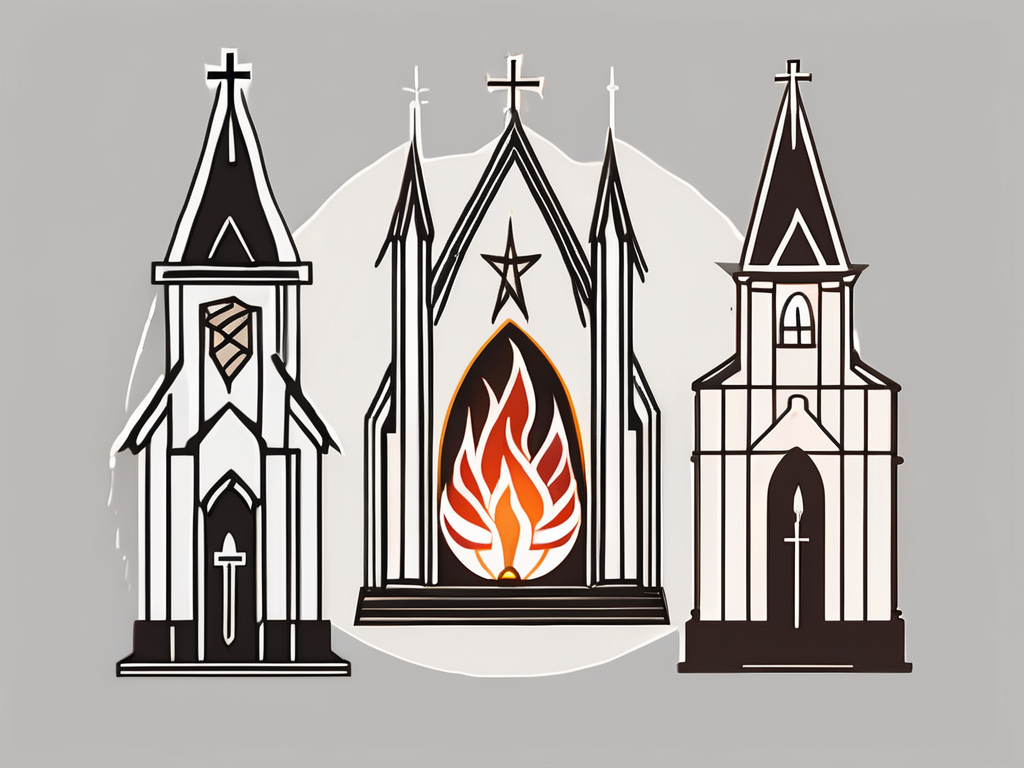In the diverse landscape of Christianity, two major denominations stand out: Protestantism and Pentecostalism. While these two faiths share some similarities, they also have distinct differences that shape their beliefs, practices, and worship styles. In this article, we will explore the origins of Protestantism and Pentecostalism, delve into their core beliefs and practices, analyze their worship styles, examine the role of the Bible in both denominations, and discuss some theological differences and similarities. By the end, we hope to gain a deeper understanding of these two influential branches of Christianity.
Exploring the Origins: Protestantism and Pentecostalism
To truly understand the differences between Protestantism and Pentecostalism, we must first delve into their origins. Protestantism traces its roots back to the 16th-century Reformation, when religious reformer Martin Luther challenged the practices and teachings of the Catholic Church. Luther’s bold stance and the subsequent formation of Protestant denominations marked a significant shift in Christian history.
Prior to the Reformation, the Catholic Church held a monopoly on Christianity in Western Europe. The church’s authority was unquestioned, and its teachings and practices were deeply ingrained in the lives of the faithful. However, as the Renaissance brought about a renewed interest in classical learning and critical thinking, some individuals began to question the church’s teachings and practices.
Martin Luther, a German monk and theologian, was one such individual. In 1517, he famously nailed his Ninety-Five Theses to the door of the All Saints’ Church in Wittenberg, Germany. These theses outlined his grievances with the Catholic Church, particularly its sale of indulgences, which were believed to grant forgiveness for sins. Luther argued that salvation could not be bought or earned through good works, but rather it was a gift of God’s grace received through faith alone.
Luther’s bold actions sparked a firestorm of controversy and led to a series of debates and theological discussions. His ideas resonated with many disillusioned Christians who were seeking a more personal and direct relationship with God. As a result, Protestantism began to take root and spread throughout Europe.
Meanwhile, Pentecostalism emerged in the early 20th century as a renewal movement within Protestantism. It is closely associated with the Azusa Street Revival in Los Angeles, California, where believers experienced powerful spiritual encounters and a resurgence of charismatic gifts and practices.
The Azusa Street Revival, led by African-American preacher William J. Seymour, started in 1906 and lasted for several years. It was characterized by intense worship, speaking in tongues, healing, and other manifestations of the Holy Spirit. The revival attracted people from diverse racial and social backgrounds, challenging the racial segregation that was prevalent at the time.
One of the key beliefs of Pentecostalism is the baptism of the Holy Spirit, which is seen as a distinct experience from conversion or water baptism. Pentecostals believe that this baptism empowers believers with spiritual gifts, such as speaking in tongues, prophecy, and healing. These gifts are seen as evidence of the presence and work of the Holy Spirit in the lives of believers.
Over the years, Pentecostalism has grown into a global movement, with millions of adherents around the world. It has influenced not only Protestant churches but also other Christian traditions, as well as new religious movements.
While Protestantism and Pentecostalism share some common roots, they have distinct theological emphases and practices. Protestantism emphasizes the authority of Scripture, justification by faith, and the priesthood of all believers. Pentecostalism, on the other hand, places a strong emphasis on the work of the Holy Spirit, spiritual gifts, and the personal experience of God’s power and presence.
Both movements have had a profound impact on the history of Christianity and continue to shape the beliefs and practices of millions of Christians today.
Core Beliefs and Practices
While both Protestants and Pentecostals identify as Christians, they have distinct beliefs and practices that shape their faith. Protestantism is characterized by its emphasis on the “Five Solas,” which include salvation by faith alone, the authority of scripture, and the priesthood of all believers. These fundamental beliefs guide Protestants in their pursuit of a personal relationship with God and their dedication to spreading the Gospel.
Protestants believe that salvation is obtained through faith alone, without any additional works or rituals. They place a strong emphasis on the authority of scripture, believing that the Bible is the inspired word of God and the ultimate source of truth. Protestants also believe in the priesthood of all believers, meaning that every individual has direct access to God and can approach Him without the need for intermediaries.
Protestant worship services are often characterized by a focus on preaching and teaching, as the Word of God is considered central to their faith. They value the study of scripture and encourage believers to deepen their understanding of God’s word through personal Bible study and participation in small groups or Bible studies. Protestants also emphasize the importance of evangelism and sharing the Gospel with others, as they believe in the Great Commission given by Jesus to spread the good news of salvation.
Pentecostalism, on the other hand, places a strong emphasis on the experience of the Holy Spirit, including the baptism of the Holy Spirit and speaking in tongues. Pentecostals believe that the gifts of the Holy Spirit, such as healing, prophecy, and miracles, are still active in the church today. They express their faith through vibrant worship services and actively seeking spiritual encounters.
Pentecostals believe that the baptism of the Holy Spirit is a separate experience from salvation and is often accompanied by speaking in tongues, which is seen as a gift of the Spirit. They believe that speaking in tongues is a form of prayer and worship that allows believers to communicate directly with God in a language unknown to them. This practice is believed to be a sign of the Holy Spirit’s presence and power.
Pentecostal worship services are characterized by a lively and expressive style. They often include energetic singing, clapping, and dancing as a way to worship and connect with God. Pentecostals believe in the power of prayer and often engage in fervent and spontaneous prayer during their services. They also believe in the laying on of hands for healing and the manifestation of spiritual gifts such as prophecy and speaking in tongues.
In addition to their emphasis on spiritual experiences, Pentecostals also place a strong emphasis on holiness and living a life that is pleasing to God. They believe in the power of the Holy Spirit to transform lives and empower believers to live a life of righteousness. Pentecostals strive to live out their faith in all aspects of their lives, seeking to be a witness for Christ in their relationships, work, and community.
Worship Styles: A Comparative Analysis
The worship styles in Protestant and Pentecostal churches also differ significantly. In Protestant worship, tradition and simplicity play a prominent role. The focus is often on biblical preaching, hymn singing, and sacraments such as baptism and communion. The atmosphere is more formal, with an emphasis on reverence and reflection.
Protestant worship services are typically structured and follow a set order of worship. The congregation gathers in a sanctuary adorned with stained glass windows, wooden pews, and a pulpit at the front. The service begins with a call to worship, where the congregation is invited to enter into a time of worship through prayer and song. The pastor then delivers a sermon, carefully crafted to expound on a biblical text and provide practical application for the congregation’s daily lives.
Throughout the service, hymns are sung, accompanied by an organ or piano. The lyrics of these hymns often reflect deep theological truths and are chosen to align with the theme of the sermon. The congregation participates by standing, sitting, and singing together, creating a sense of unity and community.
In addition to the preaching and singing, sacraments such as baptism and communion hold a significant place in Protestant worship. Baptism is seen as a symbol of initiation into the Christian faith, and it is often performed through the sprinkling or immersion of water. Communion, also known as the Lord’s Supper, is a time of remembrance and reflection on the sacrifice of Jesus Christ. The congregation partakes in bread and wine (or grape juice), symbolizing the body and blood of Christ.
On the other hand, Pentecostal worship is characterized by its high level of spiritual intensity and emotional expression. Services may include lively music, clapping, dancing, and spontaneous praise. The goal is to create an atmosphere where individuals can experience the presence of God and be moved by the power of the Holy Spirit.
Pentecostal worship services often take place in a more informal setting, such as a multipurpose room or auditorium. The stage is often adorned with contemporary instruments, including guitars, drums, and keyboards. The worship team, consisting of vocalists and musicians, leads the congregation in songs that are more contemporary in style, often incorporating elements of rock, pop, or gospel music.
During the worship service, individuals are encouraged to express their love and devotion to God freely. This can manifest in various ways, such as raising hands, clapping, or even dancing. Spontaneous praise and speaking in tongues, a phenomenon where individuals speak in a language unknown to them but believed to be a spiritual gift from the Holy Spirit, are also common in Pentecostal worship.
Overall, while both Protestant and Pentecostal worship styles aim to facilitate a connection with God, they do so in distinct ways. Protestant worship emphasizes tradition, simplicity, and a structured order of service, while Pentecostal worship focuses on spiritual intensity, emotional expression, and a more informal atmosphere. Regardless of the style, worship serves as a central aspect of the Christian faith, providing believers with an opportunity to express their devotion and draw closer to God.
The Role of the Bible in Both Denominations
Both Protestantism and Pentecostalism hold the Bible as a central authority in matters of faith and practice. However, there are some differences in their approaches. In Protestantism, the Bible is considered the ultimate authority, and the interpretation of scripture is often left to the individual or the leadership of the church. Protestant denominations may have varying views on certain theological matters.
Protestantism emerged in the 16th century as a response to the perceived corruption and excesses of the Roman Catholic Church. One of the key principles of Protestantism is the belief in sola scriptura, which means “Scripture alone.” This principle emphasizes the sufficiency of the Bible as the ultimate source of authority in matters of faith and practice. Protestants believe that the Bible contains all the necessary teachings for salvation and spiritual guidance.
Within Protestantism, there is a wide range of theological perspectives and interpretations of scripture. Some denominations place a strong emphasis on the literal interpretation of the Bible, while others adopt a more metaphorical or symbolic approach. This diversity of interpretations has led to the formation of various Protestant denominations, each with its own distinct beliefs and practices.
Similarly, Pentecostals also view the Bible as the inspired Word of God. However, they prioritize the guidance of the Holy Spirit in interpreting scripture. Pentecostalism emerged in the early 20th century as a renewal movement within Protestantism. Its adherents believe in the ongoing work of the Holy Spirit, including the manifestation of spiritual gifts such as speaking in tongues, prophecy, and healing.
In Pentecostal circles, there is often an openness to spiritual revelations and prophetic insights, which they believe complement the written Word. This emphasis on the experiential aspect of faith is reflected in their approach to interpreting the Bible. Pentecostals seek to discern the leading of the Holy Spirit as they study and apply the teachings of scripture to their lives.
Furthermore, Pentecostals place a strong emphasis on the personal relationship with God and the transformative power of the Holy Spirit. They believe that the Bible is not just a historical document or a set of moral guidelines, but a living and relevant word that speaks directly to individuals and communities today.
It is important to note that while both Protestantism and Pentecostalism hold the Bible as a central authority, their approaches to interpretation and the role of the Holy Spirit differ. These differences have led to distinctive beliefs and practices within each tradition, contributing to the rich tapestry of Christianity as a whole.
Theological Differences and Similarities
While Protestantism and Pentecostalism share a common Christian foundation, there are theological differences between the two. One major difference lies in their beliefs about salvation. Protestants often emphasize salvation by faith alone and the concept of justification, while Pentecostals also emphasize the need for a personal encounter with the Holy Spirit.
In terms of the Holy Spirit, both Protestantism and Pentecostalism acknowledge the presence and work of the Holy Spirit in the life of a believer. However, Pentecostals place a greater emphasis on the baptism of the Holy Spirit and the manifestation of spiritual gifts.
In Conclusion
Protestantism and Pentecostalism, while stemming from the same Christian heritage, have distinct differences and similarities that define their faith. Understanding these differences can foster mutual respect and appreciation among believers and promote fruitful dialogues within the diverse Christian community. Whether one identifies as Protestant or Pentecostal, what truly matters is the genuine pursuit of faith, love, and devotion to God.












